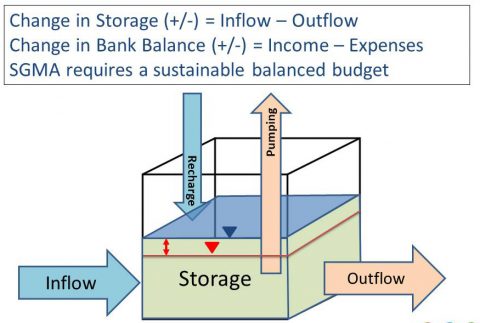A Lumped-Parameter Model for Groundwater Flow
A groundwater model expresses nothing but a balance of mass of water or mass of solute at a scale of interest.
A lumped parameter water balance model is used to simulate the temporal trends of spatially-averaged condition of the entire area of interest. This area of interest can be a groundwater basin, a watershed, or a contaminated site. The sources and sinks simulated often include: (1) the water/solute inflow components of diffuse recharge from rainfall, lateral water/solute inflow and irrigation return flow (water/solute) on the cultivated land, and (2) the water/solute outflow components as water capture from wells, springs and underground galleries, water loss from evapotranspiration and river and groundwater outflow out of the basin.


Develop an equation that describes the water and solute mass balance for the watershed as conceptualized above. Assume the water outflow (drainage to the outlet or surface water, e.g., streams) is proportional to the difference between the mean head in the aquifer and water level in the stream at the outlet:
Q = a (h-hr)
Solve the water balance equation for the aquifer head and outflow rate for the following special case:
- recharge, pumping, and injection = 0.
with the following initial condition
Solve the solute mass balance equation for the mean solute concentration as a function of time and outflow rate of solute mass for the following special case:
- concentration of recharged water = 0, pumping rate = 0, injection rate = 0
with the following initial condition:
Calculate the residence times for water and solute and comment on their relative magnitude and the factors controlling their magnitude.